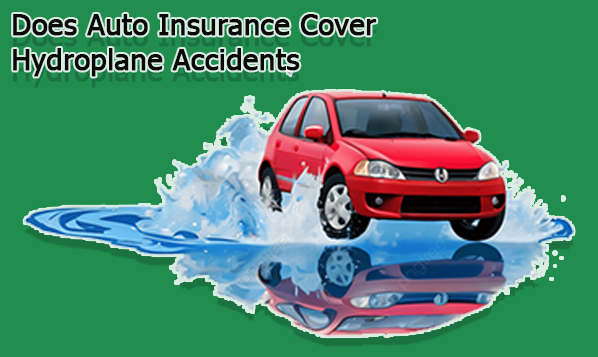There are various factors that might contribute to a car accident which can be an awful moment of our ordinary life. Accidents due to hydroplane is a typical instance. A hydroplane accident can happen when your car’s tires do not remain in touch with the road, causing severe damage to the vehicle and its travelers. But does auto insurance cover hydroplane accidents?

Depending on your insurance policy, auto insurance can cover hydroplane accidents. If you were in a single-car hydroplane accident, collision insurance would cover the harm to your vehicle. If you harm somebody else in a hydroplane car accident, your liability insurance can pay for their injuries and vehicle damage. This article will explain hydroplane accidents and offer ways to avoid them.
What is a Hydroplane Accident
Hydroplaning, in some cases known as “aquaplaning,” happens when the road gets overflowed and a car’s tires lose touch with it. This might happen during an overwhelming rain, flooding, or any other circumstance where water pools on the vehicle’s way. Moreover, in this condition, your tire continues to float on top of the water, losing footing on the ground while proceeding to move.
However, if a car exceeds 30 mph, it may hydroplane. Hydroplaning is the cause of sudden slides and skids, which happen when tires are incapable of channeling water away rapidly enough to keep up their hold on the ground underneath. This may be both staggering and harmful.
The presence of water, tire condition, and speed all increase the chance of hydroplaning accidents. The risk increases with speed since your tires’ capacity to displace water reduces. Moreover, when combined with worn tires, the danger of hydroplaning increases significantly.
What Are the Dangers of Hydroplane Accidents
Hydroplane accidents can be very frightening, especially if you are incapable of controlling the vehicle and feel it lose control. In any case, 70% of weather-related incidents and 76% of fatalities in car accidents are caused by damp pavement. Moreover, it is impossible to avoid a hydroplane disaster.
However, you may make more smart choices if you are mindful that 46% of weather-related collisions happen beneath stormy conditions. Keeping up a consistent speed is vital as the chance of hitting an aquaplane increases essentially from 30 mph to 50 mph. An accident attorney can bring a wrongful passing claim for your sake if you were hit by a vehicle that was hydroplaning or if a family member passed away in a severe crash.
Who Is Responsible In Car Accidents Caused By Hydroplaning
In car accidents caused by hydroplane, the driver is responsible since they should continuously be in control of their vehicle. However, deciding on risk might be troublesome because of things like speeding, close following, or damaged tires. Other parties may too be found mostly responsible in certain situations.
This may involve the producer of defective tires or auto parts, government offices, or road maintenance organizations for subpar road development or upkeep. Lacking signage cautioning people of potential hydroplaning danger zones may result in legitimate activity against property owners or neighborhood government offices. Furthermore, it’s common to assume that the driver is responsible, but to relegate fault, it’s important to take the incident’s circumstances and setting into consideration.
What Happens If Hydroplaning Causes a Single-car Accident
In a single weather-related car accident, the driver is frequently held responsible. Personal injury protection (PIP) or medical payment coverage may cover your therapeutic bills if you are harmed in an accident. In any case, there may be cases where the driver is not responsible when weather-related factors such as hydroplaning cause a car crash. These might include:
Manufacturing defects
If your tires or brakes come up short due to inadequate hardware, the car producer or a particular part producer may be held responsible.
Dangerous road conditions
If you hydroplane and collide since the street was ineffectively kept up and there was deficient signage caution of conceivable risks, you may be entitled to record a claim against the city or region in charge of road maintenance.
How to Avoid Hydroplane Accidents
The following are a few procedures to avoid hydroplane accidents:
- Avoid driving with worn tires
- Go below the speed limit in stormy circumstances.
- Maintain more space from other vehicles.
- Keep to the road’s inward lanes.
- Avoid utilizing voyage control.
- Slowly turn the controlling wheel instead of quickly or sharply.
- Avoid standing on water and puddles
- Ensure the tread depth of your tires is at least 2/32 of an inch by constantly checking them.
- Ensure the tires are appropriately inflated.
What to Do If You Get Into a Hydroplane Accident
The same methods that apply to any car collision would also apply to a hydroplane accident. Once you have pulled over in a secure area, check to decide whether anybody inside your car has been harmed. If another vehicle was included in the crash, ensure the passengers of that vehicle are secure as well. Finally, report the collision by calling the police and educating your insurance company.

